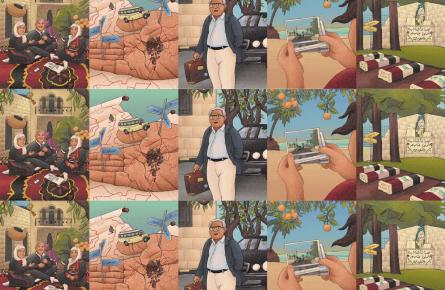In September 1993, Palestinian citizens of Israel celebrated, along with Palestinians around the world, the signing of the Oslo Accords in Washington, D.C. Despite various reservations, many had hoped that this agreement was the beginning of a resolution for the conflict, and a beginning of Palestinian liberation. For the Palestinian citizens of Israel, this had to do not only with Palestinians in the occupied territories or the diaspora, but directly touched their lives. For decades, their leadership had in many ways prioritized the struggle to end the occupation, understanding that once this issue resolved, the place and rights of Palestinians within Israel would also be protected. In the aftermath of the Oslo agreement, however, it became clear that the Palestine Liberation Organization (PLO) leadership had left them, and the Palestinian refugees, outside the scope of the negotiations. Thus, they were on their own.
Seven years later, the outbreak of the Second Intifada in September 2000 not only signaled the failure of the Oslo Accords with regard to the occupied territories, but also highlighted the urgent need for Palestinian citizens of Israel to push firmly for setting the parameters of their citizenship in Israel. For many, the Second Intifada made clear that there was little hope that the Oslo Accords could bring forth a just solution for Palestinian grievances.
[From the Journal of Palestine Studies | The Oslo Agreement as an Obstacle to Peace]
Meanwhile, attacks on Palestinians’ citizenship in Israel had been increasing. During the first week of the Intifada, Israeli police opened live fire on mass demonstrations within Israel, killing thirteen and injuring hundreds of unarmed Palestinians. Twelve of those who killed were citizens, and one came from Gaza. At the time, an Israeli-appointed commission found no justification for the use of live ammunition against demonstrators. Yet, no police officer or official was indicted. That brutal treatment, and their continuing marginalization made ever more clear to Palestinian citizens of Israel that, in essence, Israel treats all Palestinians the same, highlighting the limits of the protections availed by their citizenship. This brutality, which Palestinians on both sides of the Green Line continue to face, was connected, as Tanya Reinhart convincingly argues, to the Israeli military and political elite’s project to “complete the work of 1948.”
In light of this project, the rise of the extremist right-wing, which began with the election of Ariel Sharon in March 2001, brought with it not only an escalation of the violence in the occupied territories, but also increased attacks on Palestinians’ place within Israel itself. These attempts were, of course, not new, and had been a part of Israeli institutional policy since the state’s creation in 1948. In fact, as Shira Robinson shows, some Israeli leaders at the time tried to prevent granting them citizenship altogether. What was new in recent years, however, were the statements and acts designed to undermine the hard-earned rights and protections, for which Palestinians in Israel had struggled since the Nakba. The rise of the right-wing also brought with it a determination to affirm the “Jewishness” of the state, now being interpreted in the strictest and most exclusionary terms, including the physical exclusion of Palestinians, according to Avigdor Liberman’s Transfer plan, the “Populated-Area Exchange Plan.”
In response, Palestinian citizens of Israel turned to old-new strategies to fight against their exclusion and the attempt to void their citizenship. These included, in addition to continued protest, they engaged in a public discussion about the meaning of Israeli citizenship. Thus, in the mid-2000s, Palestinian organizations published four documents, later referred to as the “Future Vision Documents,” that laid out their vision of their place within Israel: Arabs in Israel; Constitution for All? On a Constitution and Collective Rights for Arab Citizens in Israel; The Democratic Constitution; and The Haifa Declaration. In the absence of a viable political horizon that the Oslo-based negotiations seemed to offer, the starting point for these documents was 1948, rather than 1967 or 2000. They highlighted the Nakba as a constituting event in the Palestinian-Israeli relationship, as Palestinian society was devastated, and Palestinians were turned into a minority in the state. Hence, the solution was to begin with righting the injustices of 1948, which the Oslo process had pushed aside.
[From the Journal of Palestine | The Wye Memorandum: Netanyahu’s Oslo and Unreciprocal Reciprocity]
As part of this process, Palestinian citizens of Israel challenged the discourse on Israel as a “Jewish state.” Instead, they sought to shape Israel as a truly democratic, equal, and inclusive state. They demanded the state’s recognition of their collective identity and rights, which were tied to their indigenous status, being Palestinian, Arab, and part of the Palestinian people, as well as their citizenship in Israel, which was created on their homeland. While the declarative and discursive value appear central to these documents, by combining historical discussion, legal arguments, and practical suggestions, they also sought to seriously engage Israeli officials and the public in an attempt to redefine the state through its relationship with its Palestinian citizens.
Rather than finding engagement with this proposition, Palestinian citizens of Israel were met with disregard and outright hostility, as any attempt to question the Jewishness of the state, or its right to be a Jewish state, was construed as an attack on the state’s right to exist. Instead, over the past decade, the Israeli leadership advanced the project of completing what wasn’t achieved in 1948: assert maximal Israeli domination on the land, by undermining the physical and political presence of Palestinians. In the occupied territories, this included the reoccupation of areas controlled by the Palestinian Authority (PA), the erection of the Wall, and the repeated attacks on Gaza. Inside Israel, leaders have escalated their attack on Palestinian citizens. Along with the demand that the PA to recognize Israel as a “Jewish state,” thus denying any place for the Palestinian citizens within it, the Israeli government reaffirmed exclusionary policies, at times undoing previous rights Palestinians had gained through legal battles. These included an attempt to further marginalize Arabic in the public space, and further hampering the ability of Palestinians to purchase or lease land on around 80% of the land in Israel. Most extensively, the state has accelerated its attack on the ‘unrecognized’ Bedouin villages, home to 70,000 people, in the form of the Prawer-Begin Plan, which projected the mass expulsion of the Bedouin community in the Naqab. Two villages have faced demolition since then: al-Araqib, which has been demolished over 130 times since 2010, and Umm al-Hiran, whose residents have now been forced to accept “relocation.” Home demolition in Arab villages has also increased in recent years.
[From the Journal of Palestine Studies | Challenge and Counterchallenge: Hamas’s Response to Oslo]
It is in this context that we should understand the controversial Jewish Nation-State Law, which was adopted on July 19, 2018. The law declared that “State of Israel is the national state of the Jewish people,” and that only the Jewish people have the “right to national self-determination in the State of Israel.” It also demoted the status of the Arabic language to a “special status,” rather than an official language, as it has been since 1948. This law is stark in its explicit exclusionary language. Yet, it is important to stress that the law only codified and gave constitutional validity to on-going practices, and can only be understood as the logical end-point of long-established policies.
Twenty-five years after Oslo, as a new deal by the Trump administration seems imminent, Palestinians have hopefully learned never to participate in a deal that fails to recognize them as equals to Israelis or that fails to guarantee their rights as a whole, not only within 1967 occupied territories.




